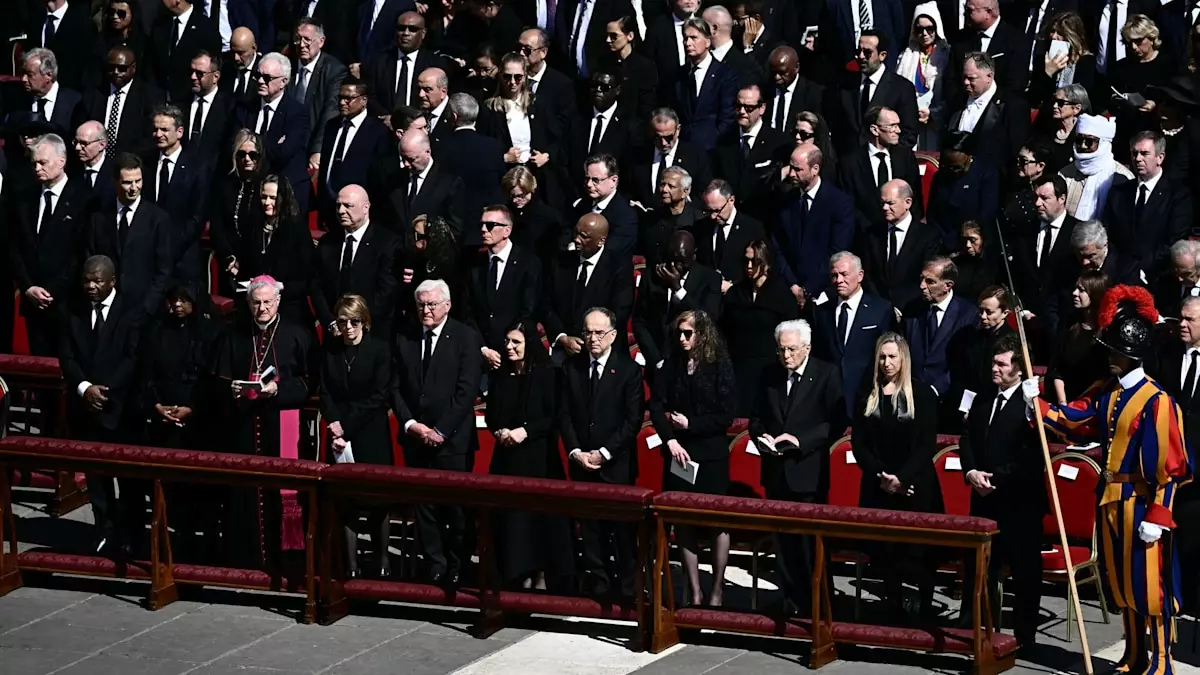Pope Francis’ funeral was not just a somber occasion to honor the late pontiff; it was an intricate ballet of diplomatic protocol and royal positioning. When Prince William along with dignitaries and royalty gathered at St. Peter’s Basilica, the world was not only mourning a spiritual leader but also observing the subtle nuances of global politics and hierarchy. Amidst the grieving thousands, William’s placement, notably distant from the central figures, caught many off guard, prompting discussions that transcended the immediate solemnity of the event. What seemed like a curious arrangement was, in reality, a calculated strategy soaked in history and etiquette intended to pacify the diverse egos occupying the hallowed halls of the Vatican.
Seating Logistics: A Masterclass in Diplomacy
Cardinal Vincent Nichols, leader of Catholics in England and Wales, shed light on the elaborate seating arrangements, referring to them as a “master plan.” However, this ‘mastery’ lies not only in the aesthetics of arrangement but also in the rich symbolism indicative of the Vatican’s deep-rooted traditions. The seating order was organized alphabetically—but intriguingly, in French. This decision highlights an enduring legacy: French is often considered the language of diplomacy. Every leader present, irrespective of their nation’s linguistic heritage, was seated according to a framework that underscores respect and formality.
This unique approach intentionally muddled what an English speaker might naturally expect, cleverly reinforcing the Vatican’s dominance in diplomatic nuance while ensuring that no nation’s leader seems overshadowed or underrepresented. For instance, while US President Donald Trump and his entourage were seated relatively close to the front, William was positioned toward the back, nestled among other leaders. It’s a stark reminder that in matters of global representation, the intricate dance of politics often plays out over emotional landscapes.
The Weight of History and Representation
Prince William’s attendance speaks volumes about the historical and contemporary ties between the Church of England and the Catholic Church. Representing King Charles III, the Prince of Wales simultaneously embodied the fragility of these interdenominational relationships as well as the weighty expectations of royal duties. The decision for William to attend alone, with Kate Middleton absent due to familial obligations, further highlights a modern interpretation of traditional roles—where royal representation is not merely a matter of presence but of symbolic importance.
This decision resonates with history, echoing King Charles’ own participation in Pope John Paul II’s funeral in 2005. These moments serve as reminders of the complex layers of allegiance that link these prominent positions, yet every generation must navigate them with a fresh perspective that is relevant to contemporary societal shifts.
The Role of the Vatican as a Diplomatic Powerhouse
The organization of such a high-profile event, where leaders from diverse backgrounds converged in solemnity, speaks to the Vatican’s historical expertise in managing the egos of powerful individuals. Cardinal Nichols noted that the Vatican has been orchestrating these grand ceremonies since the times of the emperors, adeptly placating influential figures while maintaining an atmosphere of reverence and respect. The careful orchestration of these events starkly contrasts with typical political gatherings, which can often devolve into contentious displays of power.
For those involved in or watching from afar, the seating chart provided not just a background for the service but a vivid illustration of the intersecting lanes of honor, respect, and hierarchy in international politics. Far from an afterthought, these arrangements provoke deeper reflections on identity, influence, and the evolving notions of relationships between religious and sovereign authorities.
A Reflection of Modern Monarchy
The juxtaposition of William’s role as a member of the British royal family with the solemnity and introspection of a Vatican funeral articulates the evolving nature of modern monarchy. In an age increasingly defined by the intersections of tradition and modernity, royal positioning at ceremonial events embodies not just the frayed ties of allegiance, but their potential for reconciliation. The absence of the Princess of Wales due to other commitments juxtaposed with William’s attendance raises questions about the contemporary expectations placed on royal duties and the balance between personal and public life that reigning monarchs must strike.
As the world watches these moments unfold, each leader’s position is as telling as their words, painting a portrait of a global community in mourning, yet grappling with bureaucratic complexities woven into the fabric of diplomacy. Royal or not, the seating arrangements at such pivotal ceremonies serve as critical reminders of the delicate balance between authority and humility amidst the universal experience of loss.

